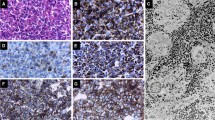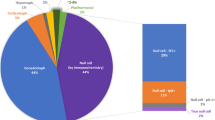Abstract
A morphological study has been carried out on 20 GH-secreting adenomas removed from acromegalic normoprolactinemic patients, on 29 PRL-secreting adenomas removed from hyperprolactinemic patients without signs of acromegaly and on one normal human anterior pituitary gland collected at autopsy. The protein A-gold immunoelectron microscopic technique has been utilized in order to verify the presence of mixed cells producing both GH and PRL (somatomammotropins) in these pituitary tissues. In the normal pituitary a considerable number of somatomammotropins (15–20%) was found, thus supporting the idea that these cells are normal components of the human anterior pituitary gland. In 10 GH-secreting adenomas and in 10 PRL-secreting adenomas somatomammotrophs were present in a variable number (from 4 to 20% of the whole cell population in GH adenomas and from 1 to 47% in PRL tumors). It can be concluded therefore that these cells, largely present in all GH/PRL-secreting adenomas, can also be found in GH-secreting and PRL-secreting tumors without clinical evidence of a mixed secretion. Adenomatous somatomammotrophs displayed ultrastructural features of adenomatous somatotrophs and mammotrophs (prominent Golgi complexes, abundant rough endoplasmic reticulum, irregular nuclei). The size and the number of granules were variable. In some cells GH and PRL were stored in distinct secretory granules, in others in mixed granules or both in mixed and distinct granules, thus suggesting that in adenomatous somatomammotrophs the efficiency of the mechanisms of sorting of the two hormones varies from one cell to another. The fact that somatomammotrophs have been found in normal pituitaries and were lacking in some tumors would suggest that in tumors these cells might originate from their normal cellular counterparts and not be a consequence of the tumoral process.
Similar content being viewed by others
References
Nakane P.K. Identification of anterior pituitary cells by immunoelectron microscopy. In: Tixier-Vidal A., Farquhar M.G. (Eds.), The anterior pituitary. Academic Press, New York, 1975, p. 45.
Goluboff L.G., Ezrin C. Effect of pregnancy on the somatotroph and the prolactin cell of the human adenohypophysis. J. Clin. Endocrinol. Metab. 29: 1533, 1969.
Tashjian A.H. Jr., Bancroft F.C., Levine L. Production of both prolactin and growth hormone by clonal strains of rat pituitary tumor cells. J. Cell Biol. 47: 61, 1970.
Stratmann I.E., Ezrin C., Sellers E.A. Estrogen-induced transformation of somatotrophs into mammotrophs in the rat. Cell Tissue Res. 152: 229, 1974.
Zimmermann E.A., Defendini R., Frantz A.G. Prolactin and growth hormone in patients with pituitary adenomas: a correlative study of hormone in tumor and plasma by immunoperoxidase technique and radioimmunoassay. J. Clin. Endocrinol. Metab. 38: 577, 1974.
Halmi N.S. Occurrence of both growth hormone- and prolactin-immunoreactive material in the cells of human somatotropic pituitary adenomas containing mammotropic elements. Virchows Arch. (Pathol. Anat.) 398: 19, 1982.
Ishikawa H., Nogami H., Kamio M., Suzuki T. Single secretory granules contain both GH and prolactin in pituitary mixed type of adenoma. Virchows Arch. (Pathol. Anat.) 399: 221, 1983.
Kanie N., Kageyama N., Kuwayama A., Nakane T., Watanabe M., Kawaoi A. Pituitary adenomas in acromegalic patients: an immunohistochemical and endocrinological study with special reference to prolactin-secreting adenoma. J. Clin. Endocrinol. Metab. 57: 1093, 1983.
Melmed S., Braunstein G.D., Horvath E., Ezrin C., Kovacs K. Pathophysiology of acromegaly. Endocr. Rev. 4: 271, 1983.
Roth J., Ravazzola M., Bendayan M., Orci L. Application of the protein A-gold technique for electron microscopic demonstration of polypeptide hormones. Endocrinology 108: 247, 1981.
Bendayan M., Zollinger M. Ultrastructural localization of antigenic sites on osmium-fixed tissues applying the protein A-gold technique. J. Histochem. Cytochem. 31: 101, 1983.
Neill J.D., Frawley L.S. Detection of hormone release from individual cells in mixed populations using a reverse hemolytic plaque assay. Endocrinology 112: 1135, 1983.
Frawley L.S., Boockfor F.R., Hoeffler J.P. Identification by plaque assay of a pituitary cell type that secretes both growth hormone and. prolactin. Endocrinology 116: 734, 1985.
Fumagalli G., Zanini A. In cow anterior pituitary growth hormone and prolactin can be packaged in separate granule of the same cell. J. Cell Biol. 100: 2019, 1985.
Mikitovitch-Winer M.B., Atkin J., Maley B.E. Colocalization of prolactin and growth hormone within specific adenohypophyseal cells in male, female and lactating female rats. Endocrinology 121: 625, 1987.
Lloyd R.V., Anagnostou D., Cano M., Barkan L., Chandler W.F. Analysis of mammosomatotropic cells in normal and neoplastic human pituitary tissues by the reverse hemolytic plaque assay and immunoctyochemistry. J. Clin. Endocrinol. Metab. 66: 1103, 1988.
Boockfor F.R., Schwarz L.K. Cultures of GH3 cells contain both single and dual hormone secretors. Endocrinology 122: 762, 1988.
Bassetti M., Spada A., Arosio M., Vallar L., Brina M. and Giannattasio G. Morphological studies on mixed growth hormone (GH) — and prolactin (PRL) — secreting human pituitary adenomas. Coexistence of GH and PRL in the same secretory granule. J. Clin. Endocrinol. Metab. 62: 1093, 1986.
Felix I.A., Horvath E., Kovacs K., Smyth H.S., Killinger D.W., Vale J. Mammosomatotroph adenoma of the pituitary associated with gigantism and hyperprolactinemia. A morphological study including immunoelectron microscopy. Acta Neuropathol. 71: 76, 1986.
Zurschmiede C., Landolt A.M. Distribution of growth hormone and prolactin in secretory granules of the normal and neoplastic human adenohypophysis. Virchows Arch. B 53: 308, 1987.
Beckers A., Courtoy R., Stevenaert A., Boniver J., Closset J., Frankenne F., Reznik M., Hennen G. Mammosomatotropes in human pituitary adenomas as revealed by electron microscopic double gold immunostaining method. Acta Endocrinol. (Kbh.) 118: 503, 1988.
Beck-Peccoz P., Bassetti M., Spada A., Medri G., Arosio M., Giannattasio G., Faglia G. Glycoprotein hormone alpha-subunit response to growth hormone-releasing factor (GRF) in patients with active acromegaly. Evidence for alpha-subunit and GH coexistence in the same tumoral cell. J. Clin. Endocrinol. Metab. 61: 541, 1985.
Beck-Peccoz P., Piscitelli G., Amr S., Ballabio M., Bassetti M., Giannattasio G., Spada A., Nissim M., Weintraub B.D., Faglia G. Endocrine, biochemical, and morphological studies of a pituitary adenoma secreting growth hormone, thyrotropin (TSH), and alpha-subunit: evidence for secretion of TSH with increased bioactivity. J. Clin. Endocrinol. Metab. 62: 704, 1986.
Travaglini P., Bassetti M., Spada A., Togni M.E., Faglia G. Mixed LH, FSH, GH pituitary microadenoma: clinical and morphological studies. In: Landolt A.M. (Ed.) Advances in the Biosciences. Pergamon Press, 1988, vol. 69, p. 435.
Slot J.W., Geuze J.J. Sizing of protein A-colloidal gold probes for immunoelectron microscopy. J. Cell Biol. 90: 533, 1981.
Spada A., Sartorio A., Bassetti M., Pezzo G., Giannattasio G. In vitro effect of dopamine on growth hormone (GH) release from human GH-secreting pituitary adenomas. J. Clin. Endocrinol. Metab. 55: 734, 1982.
Geuze H.J., Slot J.W., Van Der Ley P.A., Scheffer R.C.T., Griffith J.M. Use of colloidal particles in double-labeling immunoelectron microscopy of ultrathin frozen tissue sections. J. Cell Biol. 89: 653, 1981.
Kovacs K., Horvath E., Thorner M.O., Rogol A.D. Mammosomatotroph hyperplasia associated with acromegaly and hyperprolactinemia in a patient with the McCune-Albright syndrome. Virchows Arch. (Pathol. Anat.) 403: 77, 1984.
Author information
Authors and Affiliations
Rights and permissions
About this article
Cite this article
Bassetti, M., Brina, M., Spada, A. et al. Somatomammotropin cells in GH-secreting and PRL-secreting human pituitary adenomas. J Endocrinol Invest 12, 705–712 (1989). https://doi.org/10.1007/BF03350037
Received:
Accepted:
Published:
Issue Date:
DOI: https://doi.org/10.1007/BF03350037




